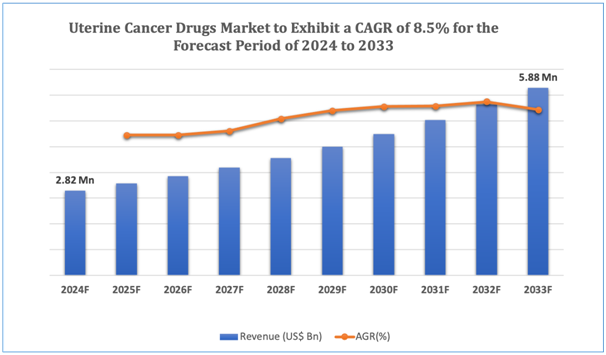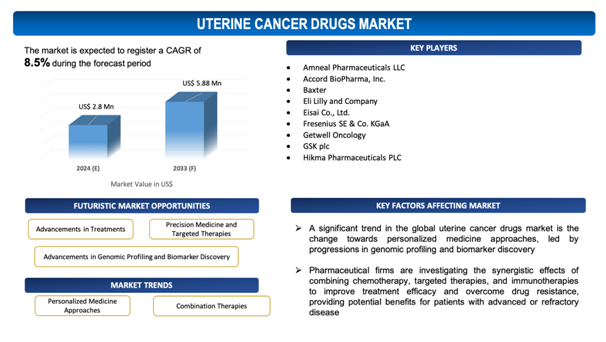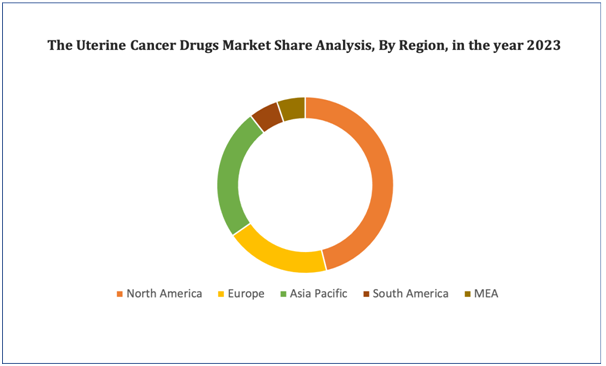Uterine Cancer Drugs Market Overview
The global Uterine Cancer Drugs market is estimated to be worth over USD 5.88 Mn in 2033 and is expected to grow at CAGR of8.5% during the forecast period (2024-2033).
Uterine cancer, also referred to as endometrial cancer, portrays a crucial healthcare challenge across the globe, fuelling the demand for effective treatment alternatives and defining the panorama of uterine cancer drugs market. Uterine cancer arises when unusual cells develop and multiply in the lining of the uterus, which may lead to the development of tumors. The prevalence of uterine cancer has been on the surge, principallyowing to factors such as geriatric populations, hormonal imbalances, obesity, and genetic predispositions. As a consequence, the global market for uterine cancer drugs has experiencedstable growth, with pharmaceutical firms investing in research and development to tackle the unmet medical needs in this domain.
In current times, the standard of care for uterine cancer comprises a confluence of surgery, chemotherapy, and radiation therapy, depending on the stage and severity of the disease. Chemotherapy drugs such as carboplatin, paclitaxel, and doxorubicin are generally used to kill cancer cells and avoid their spread. Hormonal therapies, such as progesterone receptor modulators and aromatase inhibitors, are also likely to be prescribed to administer hormone-driven tumors. In addition, targeted therapies, comprising monoclonal antibodies and tyrosine kinase inhibitors, focuson blockingparticular pathways involved in cancer growth and progression.
The global market for uterine cancer drugs is marked by intense competition among pharmaceutical companies vying to develop advanced therapies with enhanced efficacy and lesseradverse effects. Biomarker-driven approaches and personalized medicine strategies are essentially being explored to determine patients who are most likely to benefit from specific treatments, thereby optimizing therapeutic outcomes and minimizing treatment-associated toxicities. Along with that, advancements in drug delivery technologies, such as nanoparticle-based formulations and sustained-release systems, hold commitment for improving drug efficacy and patient compliance.
Notwithstanding with these advancements, challenges such as treatment toxicities, drug resistance, and increased treatment costs remain major hurdles in the uterine cancer drugs market. In parallel, disparities in access to healthcare services and limited awareness about uterine cancer screening and prevention efforts contribute to delayed diagnoses and poorer outcomes in some regions. Nevertheless, continuing research and development initiatives, along with increasing investments in precision medicine and targeted therapies, are estimated to fuelsustained innovation and growth in the global uterine cancer drugs market, ultimately enhancing outcomes for patients affected by this devastating disease.
Figure 1. Uterine Cancer Drugs: Market Size

Get more details on this report - Request Free Sample
Key Market Insights &Current Market Landscape:
The global uterine cancer drugs market is marked by substantial insights and a dynamic panoramaspurred by various factors. In the current times, the market is experiencingsignificant developments in treatment modalities and novel technologies emphasized at addressing the unmet medical needs in uterine cancer management. Major insights showcase a growing incidence of uterine cancer across the world, owing to factors such as geriatric populations, hormonal imbalances, obesity, an genetic predispositions. This trend underlines the pressing need for effective treatment alternatives to enhance patient outcomes and mitigate mortality rates associated with this disease.
In response to these challenges, pharmaceutical firms are investing in research and development efforts to innovate new therapies and improve existing treatment modalities. Substantial developments in the market comprise the advent of targeted therapies, hormonal therapies, and immunotherapies, which aim to selectively target cancer cells while mitigating damage to healthy tissues. In addition, advancements in drug delivery technologies, such as nanoparticle-based formulations and sustained-release systems, are allowingenhanced drug efficacy and patient compliance.
Along with that, the advent of biomarker-driven approaches and personalized medicine strategies is transforming uterine cancer treatment by determining patients who are most likely to benefit from specific therapies on the basis of their genetic makeup and tumor characteristics. This precision medicine approach enables for more tailored and effective treatment regimens, ultimately enhancing patient outcomes and quality of life.
Overall, the current market panorama of the global uterine cancer drugs market is marked by innovation, advancements in treatment modalities, and a soaring focus on personalized medicine. As research and development efforts continue to advance, the market stands ready for further growth and evolution, offering promise for enhanced outcomes and better quality of life for patients affected by uterine cancer.
Market Dynamics
Market Drivers
Rising Incidence of Uterine Cancer Worldwide
The rising incidence of uterine cancer worldwide presents as a major market driver for the global uterine cancer drugs market, spurring demand for effective treatment options to tackle the growing burden of this disease. Uterine cancer represents one of the most common gynaecological malignancies across the globe, with its prevalence steadily growing in the past few years. Several factors contribute to this upward trend, comprisinggeriatric populations, hormonal imbalances, obesity, and genetic predispositions. Since populations age and lifestyles change, the incidence of uterine cancer surges, necessitating urgent interventions to battle this alarming trend.
In March 2023, according to an article published by the American Society of Clinical Oncology (ASCO), uterine cancer is the fourth most common cancer for women in the U.S., worldwide an estimated 417,367 people were diagnosed with uterine cancer in 2020. The surge in uterine cancer cases underscores the essential need for innovative therapies and treatment modalities to enhance patient outcomes and reduce mortality rates associated with this disease. Pharmaceutical companies are actively investing in research and development efforts to develop and innovate new drugs and enhance existing treatment alternatives for uterine cancer patients. These efforts focuson developing targeted therapies, hormonal therapies, and immunotherapies that selectively target cancer cells while mitigatingside effects on healthy tissues. Along with that, advancements in diagnostic techniques and biomarker-driven approaches allow earlier detection of uterine cancer and personalized treatment strategies tailored to individual patient characteristics.
Market Restraints
With regard to numerous advantages of Uterine Cancer Drugs, the market faces several challenges due to the unique characteristics and requirements associated with them. Some of the key market challenges include:
- Treatment Toxicities: Some uterine cancer drugs are estimated to cause substantial adverse effects, such as fatigue, nausea, and hair loss, which can impact patient quality of life and treatment adherence.
- High Treatment Costs: The cost of uterine cancer drugs, specifically newer and targeted therapies, can be prohibitively expensive, confining access for some patients and healthcare systems.
Market Opportunities
Advancements in Genomic Profiling and Biomarker Discovery
These innovations have transformed the panorama of cancer treatment by allowing the determination of specific genetic mutations and biomarkers related to uterine cancer subtypes. This enables for more accurate and personalized treatment approaches customized to individual patient characteristics, which may lead toenhancing therapeutic outcomes. By facilitating genomic profiling techniques such as next-generation sequencing and gene expression profiling, researchers can better understand the underlying molecular mechanisms fueling uterine cancer progression and determine novel therapeutic targets. In addition, biomarker discovery efforts focuson developing predictive markers that can stratify patients based on their likelihood of responding to specific treatments, enabling more targeted and effective interventions. This personalized medicine approach not only enhances treatment efficiency but also mitigates treatment-associated toxicities and enhances patient quality of life. In parallel, advancements in companion diagnostic tests support the selection of the most appropriate therapy for each patient, optimizing treatment decisions and spurring market growth. Therefore, the integration of genomic profiling and biomarker discovery into uterine cancer drug development holds commitment for advancing precision medicine and revolutionizing the standard of care for patients with uterine cancer.
Market Trends
- Personalized Medicine Approaches: A significant trend in the global uterine cancer drugs market is the change towards personalized medicine approaches, led by progressions in genomic profiling and biomarker discovery. This trend comprising tailoring treatment regimens to individual patient characteristics, such as genetic mutations and biomarker expression profiles, to optimize therapeutic outcomes and reduce treatment-related toxicities.
- Combination Therapies: Another emerging trend is the exploration of combination therapies in uterine cancer treatment, comprising the simultaneous administration of multiple drugs or treatment modalities. Pharmaceutical firms are investigating the synergistic effects of combining chemotherapy, targeted therapies, and immunotherapies to improve treatment efficacy and overcome drug resistance, providing potential benefits for patients with advanced or refractory disease.

Get more details on this report - Request Free Sample
Uterine Cancer Drugs Market: Key Segments
By Cancer Type
- Endometrial Cancer
- Uterine Sarcoma
By Treatment Type
- Chemotherapy
- Immunotherapy
- Hormone Therapy
- Targeted Therapy
- Others
By Drug Type
- Generics
- Branded
By Age Group
- Geriatric
- Adults
By Route of Administration
- Parenteral
- Oral
By End-User
- Hospitals
- Cancer Centres
- Specialty Clinics
- Others
By Distribution Channel
- Direct Tender
- Retail Sales
- Others
By Key Geographical Regions
- North America
- Europe
- Asia-Pacific
- Middle East and Africa
- South America
Uterine Cancer Drugs Market: Regional Analysis
The U.S. is expected to dominate the North America region due to the rise in technological advancement in uterine cancer drugs products market. Germany is expected to dominate the Europe region due to the strong presence of key players. China is expected to dominate the Asia-Pacific region due to the mass production of uterine cancer drugs based products and increasing demand from emerging markets and expansion.
Figure 4. Uterine Cancer Drugs Market: Distribution by Region

Get more details on this report - Request Free Sample
Leading Uterine Cancer Drugs Developers
Industry Trends and Global Forecasts, 2023-2035 report features an extensive study of the current market landscape, market size and future opportunities associated with the Uterine Cancer Drugsmarket, during the given forecast period. Further, the market report highlights the efforts of several stakeholders engaged in this rapidly emerging segment of the biopharmaceutical industry. Key takeaways of the Uterine Cancer Drugsmarket is briefly discussed below.
The report includes the list of players operating in the global Uterine Cancer Drugsmarket. Some of the key players include:
- Amneal Pharmaceuticals LLC
- Accord BioPharma, Inc.
- Baxter
- Eli Lilly and Company
- Eisai Co., Ltd.
- Fresenius SE & Co. KGaA
- Getwell Oncology
- GSK plc
- Hikma Pharmaceuticals PLC
- Merck & Co., Inc.
- Pfizer Inc.
- Sanofi
- Sun Pharmaceutical Industries Ltd.
- Teva Pharmaceuticals USA, Inc.
- Viatris Inc.
- Virtus
Recent Developments in the Uterine Cancer DrugsMarket
Several recent developments have taken place in the field of Uterine Cancer Drugs, some of which have been outlined below. These developments, even if they took place post the release of our market report, substantiate the overall market trends that we’ve outlined in our analysis chronologically.
- In July 2023,GSK plc announced that the US Food and Drug Administration (FDA) has approved Jemperli(dostarlimab) in combination with carboplatin and paclitaxel, followed by Jemperli as a single agent for the treatment of adult patients with primary advanced or recurrent endometrial cancer that is mismatch repair deficient (dMMR), as determined by an FDA-approved test, or microsatellite instability-high (MSI-H). The supplemental Biologics License Application (sBLA) supporting this new indication received Priority Review and was approved ahead of the Prescription Drug User Fee Act action date.
Scope of the Report
The market report presents an in-depth analysis of the various firms / organizations that are engaged in this market, across different segments, as defined in the below table:
|
Key Report Attributes |
Details |
|
Base Year |
2023 |
|
Forecast Period |
2024-2033 |
|
CAGR (2024-2033) |
8.5% |
|
Cancer Type |
|
|
Treatment Type |
|
|
Drug Type |
|
|
Age Group |
|
|
Route of Administration |
|
|
End User |
|
|
Distribution Channel |
|
|
Key Geographical Regions |
|
|
Key Companies Profiled |
|
